Calculus Assignment: Derivatives, Tangent Lines, and Functions
VerifiedAdded on 2023/04/07
|11
|2037
|430
Homework Assignment
AI Summary
This calculus assignment provides solutions to several problems related to derivatives and their applications. The first question explores derivative formulas, including the power rule and the limit definition of a derivative, and applies them to find the derivative of a function. The second question focuses on differentiating various functions using established rules, such as the product rule, quotient rule, and chain rule. The third question involves finding both the first and second derivatives of a given function. Question four requires finding the equation of a tangent line at a specific point. The fifth question involves finding derivatives of functions using values in a table. Finally, the sixth question uses graphs to estimate derivatives and the seventh question applies derivative rules to find derivatives of composite functions. The assignment offers detailed solutions and explanations for each problem, providing a comprehensive review of fundamental calculus concepts.
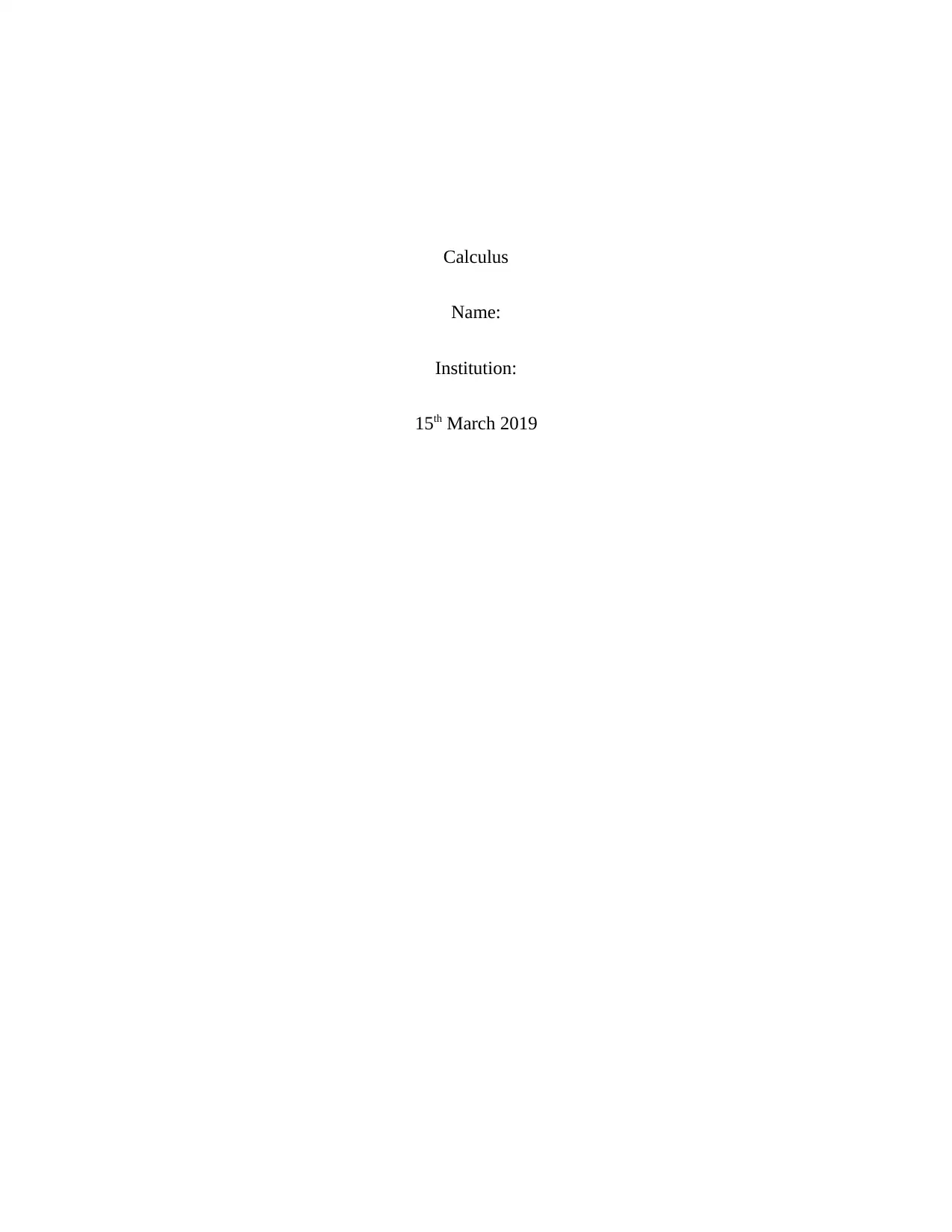
Calculus
Name:
Institution:
15th March 2019
Name:
Institution:
15th March 2019
Paraphrase This Document
Need a fresh take? Get an instant paraphrase of this document with our AI Paraphraser
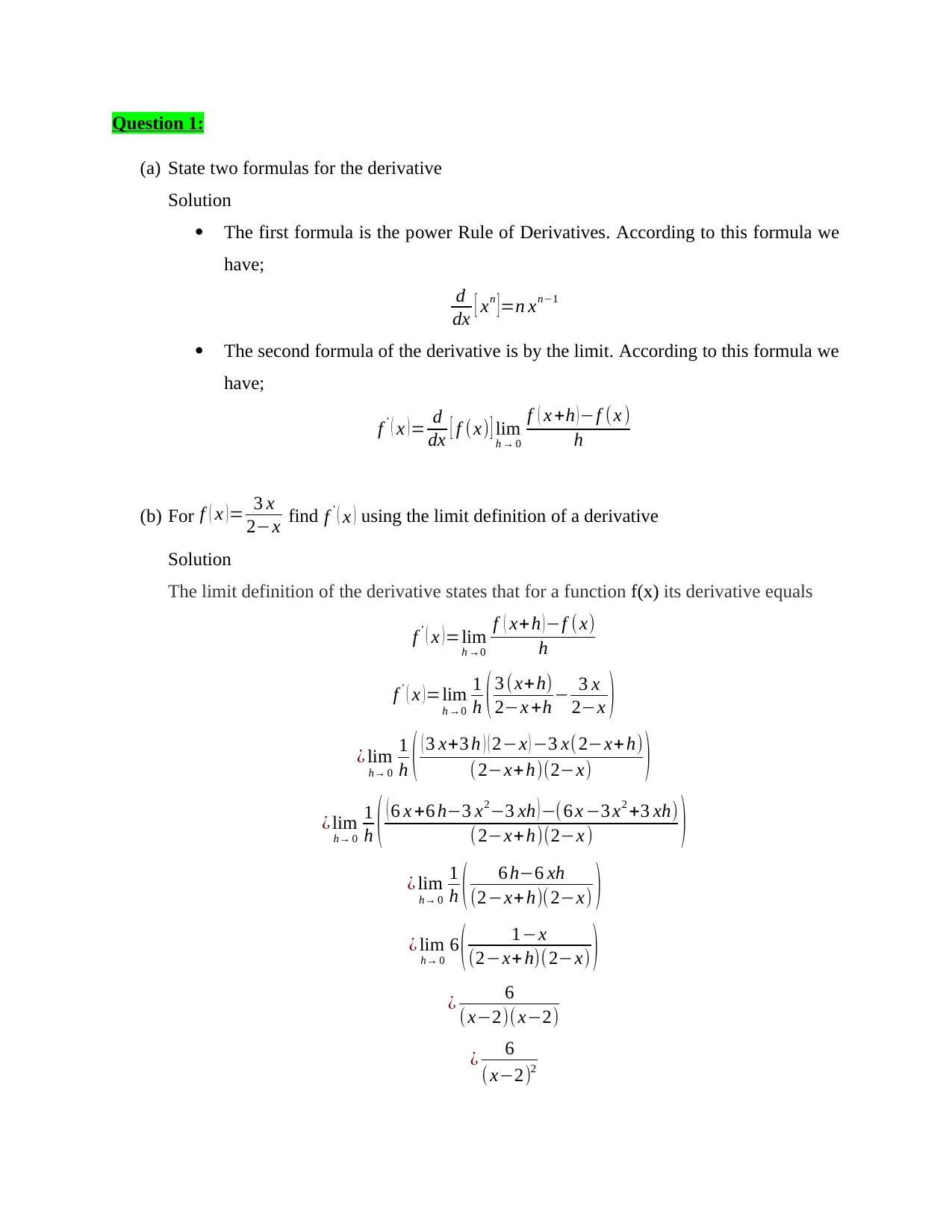
Question 1:
(a) State two formulas for the derivative
Solution
The first formula is the power Rule of Derivatives. According to this formula we
have;
d
dx [ xn ]=n xn−1
The second formula of the derivative is by the limit. According to this formula we
have;
f ' ( x ) = d
dx [ f (x) ] lim
h → 0
f ( x +h ) −f (x )
h
(b) For f ( x )= 3 x
2−x find f ' ( x ) using the limit definition of a derivative
Solution
The limit definition of the derivative states that for a function f(x) its derivative equals
f ' ( x )=lim
h →0
f ( x+h )−f (x)
h
f ' ( x ) =lim
h →0
1
h ( 3 (x+h)
2−x +h − 3 x
2−x )
¿ lim
h→ 0
1
h ( ( 3 x+3 h ) ( 2−x ) −3 x(2−x+ h)
( 2−x+h)(2−x) )
¿ lim
h→ 0
1
h ( ( 6 x +6 h−3 x2−3 xh ) −(6 x −3 x2 +3 xh)
(2−x+h)(2−x ) )
¿ lim
h→ 0
1
h ( 6 h−6 xh
(2−x+h)(2−x) )
¿ lim
h→ 0
6 ( 1−x
(2−x+ h)(2−x) )
¿ 6
(x−2)( x−2)
¿ 6
( x−2)2
(a) State two formulas for the derivative
Solution
The first formula is the power Rule of Derivatives. According to this formula we
have;
d
dx [ xn ]=n xn−1
The second formula of the derivative is by the limit. According to this formula we
have;
f ' ( x ) = d
dx [ f (x) ] lim
h → 0
f ( x +h ) −f (x )
h
(b) For f ( x )= 3 x
2−x find f ' ( x ) using the limit definition of a derivative
Solution
The limit definition of the derivative states that for a function f(x) its derivative equals
f ' ( x )=lim
h →0
f ( x+h )−f (x)
h
f ' ( x ) =lim
h →0
1
h ( 3 (x+h)
2−x +h − 3 x
2−x )
¿ lim
h→ 0
1
h ( ( 3 x+3 h ) ( 2−x ) −3 x(2−x+ h)
( 2−x+h)(2−x) )
¿ lim
h→ 0
1
h ( ( 6 x +6 h−3 x2−3 xh ) −(6 x −3 x2 +3 xh)
(2−x+h)(2−x ) )
¿ lim
h→ 0
1
h ( 6 h−6 xh
(2−x+h)(2−x) )
¿ lim
h→ 0
6 ( 1−x
(2−x+ h)(2−x) )
¿ 6
(x−2)( x−2)
¿ 6
( x−2)2
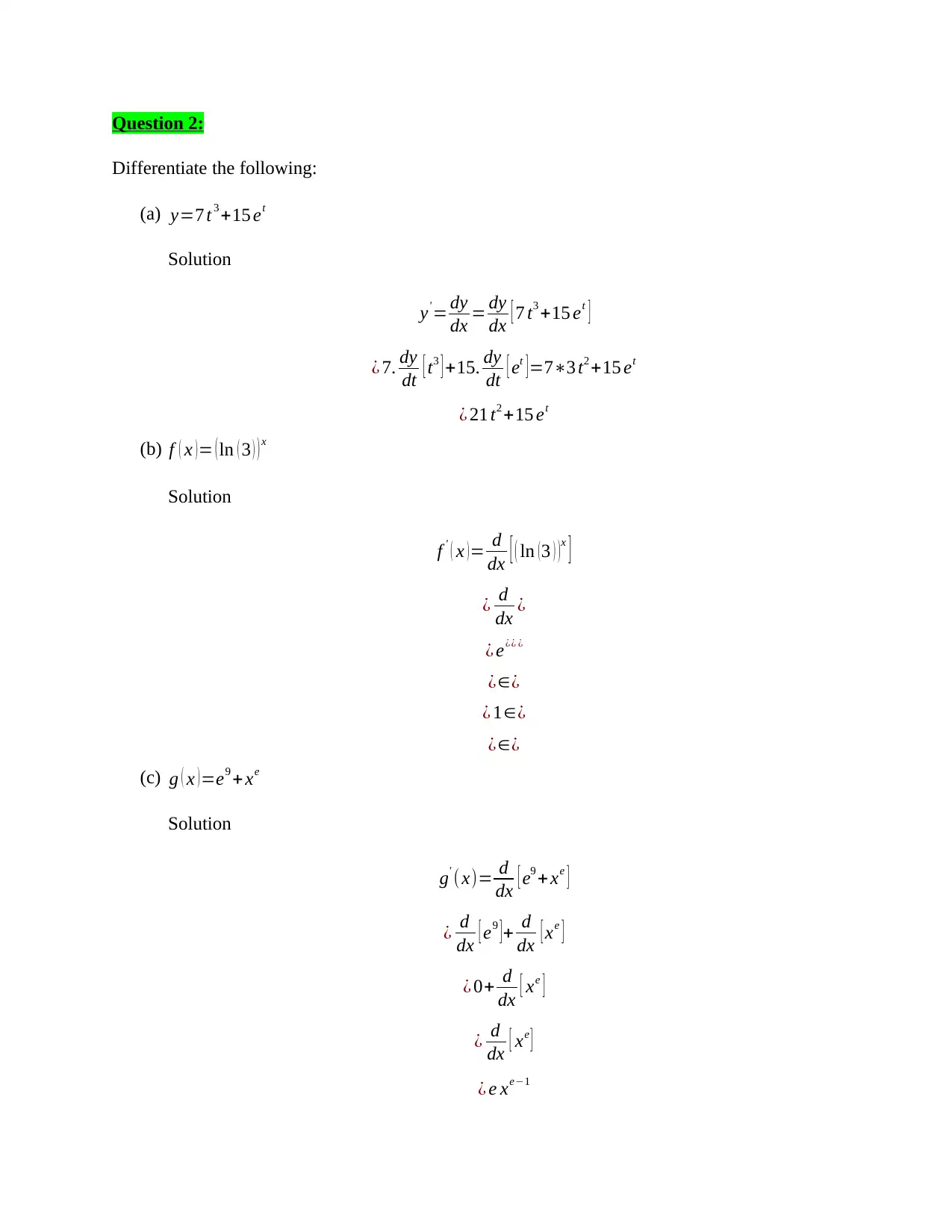
Question 2:
Differentiate the following:
(a) y=7 t 3 +15 et
Solution
y' = dy
dx = dy
dx [ 7 t3 +15 et ]
¿ 7. dy
dt [ t3 ] +15. dy
dt [ et ] =7∗3 t2 +15 et
¿ 21 t2 +15 et
(b) f ( x ) = ( ln ( 3 ) ) x
Solution
f ' ( x )= d
dx [ ( ln (3 ) )x
]
¿ d
dx ¿
¿ e¿¿ ¿
¿∈¿
¿ 1∈¿
¿∈¿
(c) g ( x ) =e9 + xe
Solution
g' ( x)= d
dx [ e9 + xe ]
¿ d
dx [ e9 ]+ d
dx [ xe ]
¿ 0+ d
dx [ xe ]
¿ d
dx [ xe ]
¿ e xe−1
Differentiate the following:
(a) y=7 t 3 +15 et
Solution
y' = dy
dx = dy
dx [ 7 t3 +15 et ]
¿ 7. dy
dt [ t3 ] +15. dy
dt [ et ] =7∗3 t2 +15 et
¿ 21 t2 +15 et
(b) f ( x ) = ( ln ( 3 ) ) x
Solution
f ' ( x )= d
dx [ ( ln (3 ) )x
]
¿ d
dx ¿
¿ e¿¿ ¿
¿∈¿
¿ 1∈¿
¿∈¿
(c) g ( x ) =e9 + xe
Solution
g' ( x)= d
dx [ e9 + xe ]
¿ d
dx [ e9 ]+ d
dx [ xe ]
¿ 0+ d
dx [ xe ]
¿ d
dx [ xe ]
¿ e xe−1
⊘ This is a preview!⊘
Do you want full access?
Subscribe today to unlock all pages.

Trusted by 1+ million students worldwide
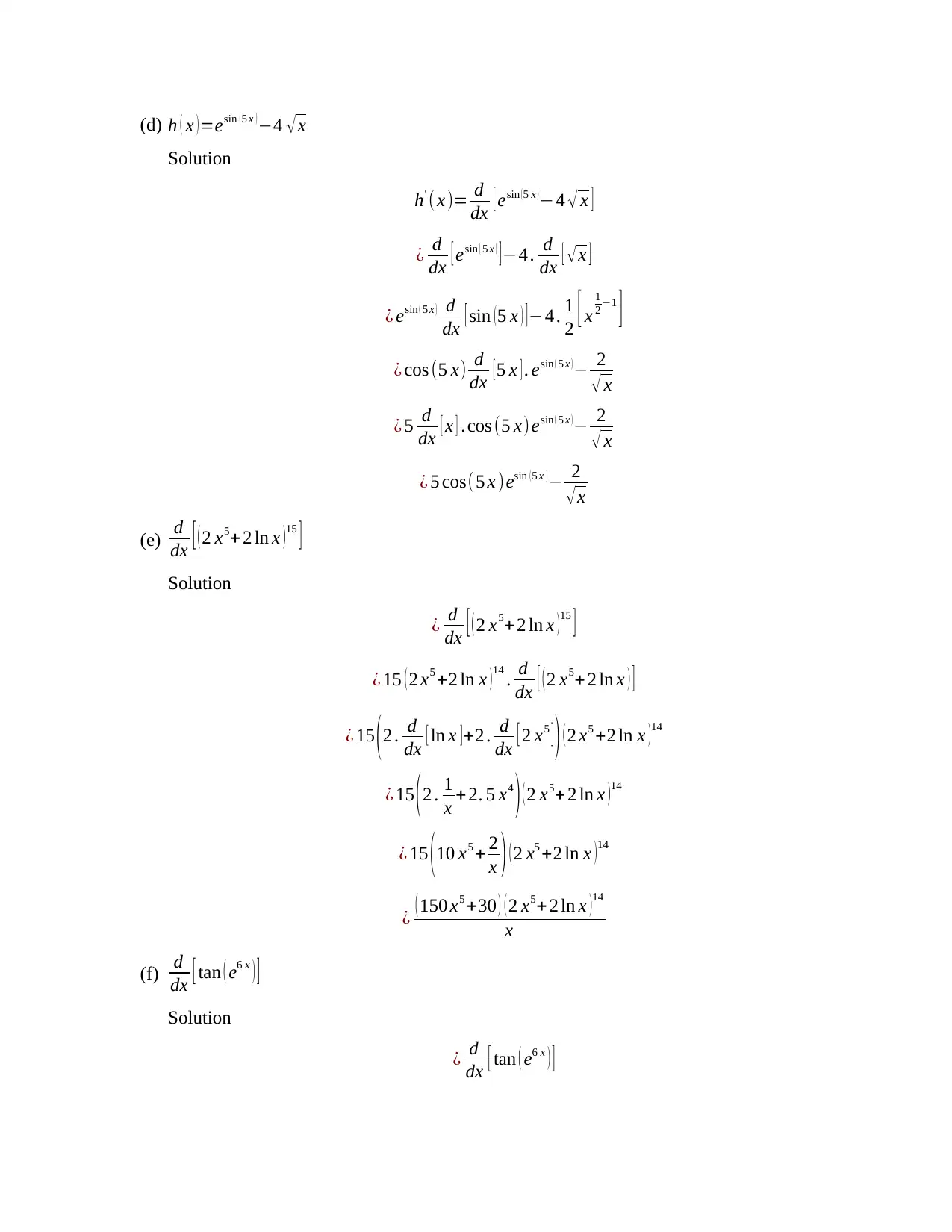
(d) h ( x ) =esin ( 5 x ) −4 √ x
Solution
h' ( x )= d
dx [ esin (5 x )−4 √ x ]
¿ d
dx [ esin ( 5 x ) ]−4 . d
dx [ √ x ]
¿ esin ( 5 x ) d
dx [ sin (5 x ) ]−4 . 1
2 [ x
1
2 −1
]
¿ cos (5 x) d
dx [5 x ] . esin ( 5 x )− 2
√ x
¿ 5 d
dx [ x ] .cos (5 x)esin ( 5 x )− 2
√ x
¿ 5 cos(5 x )esin ( 5 x ) − 2
√ x
(e) d
dx [ ( 2 x5+ 2 ln x )
15
]
Solution
¿ d
dx [ ( 2 x5+2 ln x )15
]
¿ 15 ( 2 x5 +2 ln x ) 14
. d
dx [ ( 2 x5+ 2 ln x ) ]
¿ 15 ( 2 . d
dx [ ln x ] +2 . d
dx [ 2 x5 ] ) ( 2 x5 +2 ln x )
14
¿ 15 ( 2 . 1
x + 2. 5 x4
) ( 2 x5+ 2 ln x )
14
¿ 15 (10 x5 + 2
x ) ( 2 x5 +2 ln x )14
¿ ( 150 x5 +30 ) ( 2 x5+ 2 ln x )
14
x
(f) d
dx [ tan ( e6 x ) ]
Solution
¿ d
dx [ tan ( e6 x ) ]
Solution
h' ( x )= d
dx [ esin (5 x )−4 √ x ]
¿ d
dx [ esin ( 5 x ) ]−4 . d
dx [ √ x ]
¿ esin ( 5 x ) d
dx [ sin (5 x ) ]−4 . 1
2 [ x
1
2 −1
]
¿ cos (5 x) d
dx [5 x ] . esin ( 5 x )− 2
√ x
¿ 5 d
dx [ x ] .cos (5 x)esin ( 5 x )− 2
√ x
¿ 5 cos(5 x )esin ( 5 x ) − 2
√ x
(e) d
dx [ ( 2 x5+ 2 ln x )
15
]
Solution
¿ d
dx [ ( 2 x5+2 ln x )15
]
¿ 15 ( 2 x5 +2 ln x ) 14
. d
dx [ ( 2 x5+ 2 ln x ) ]
¿ 15 ( 2 . d
dx [ ln x ] +2 . d
dx [ 2 x5 ] ) ( 2 x5 +2 ln x )
14
¿ 15 ( 2 . 1
x + 2. 5 x4
) ( 2 x5+ 2 ln x )
14
¿ 15 (10 x5 + 2
x ) ( 2 x5 +2 ln x )14
¿ ( 150 x5 +30 ) ( 2 x5+ 2 ln x )
14
x
(f) d
dx [ tan ( e6 x ) ]
Solution
¿ d
dx [ tan ( e6 x ) ]
Paraphrase This Document
Need a fresh take? Get an instant paraphrase of this document with our AI Paraphraser
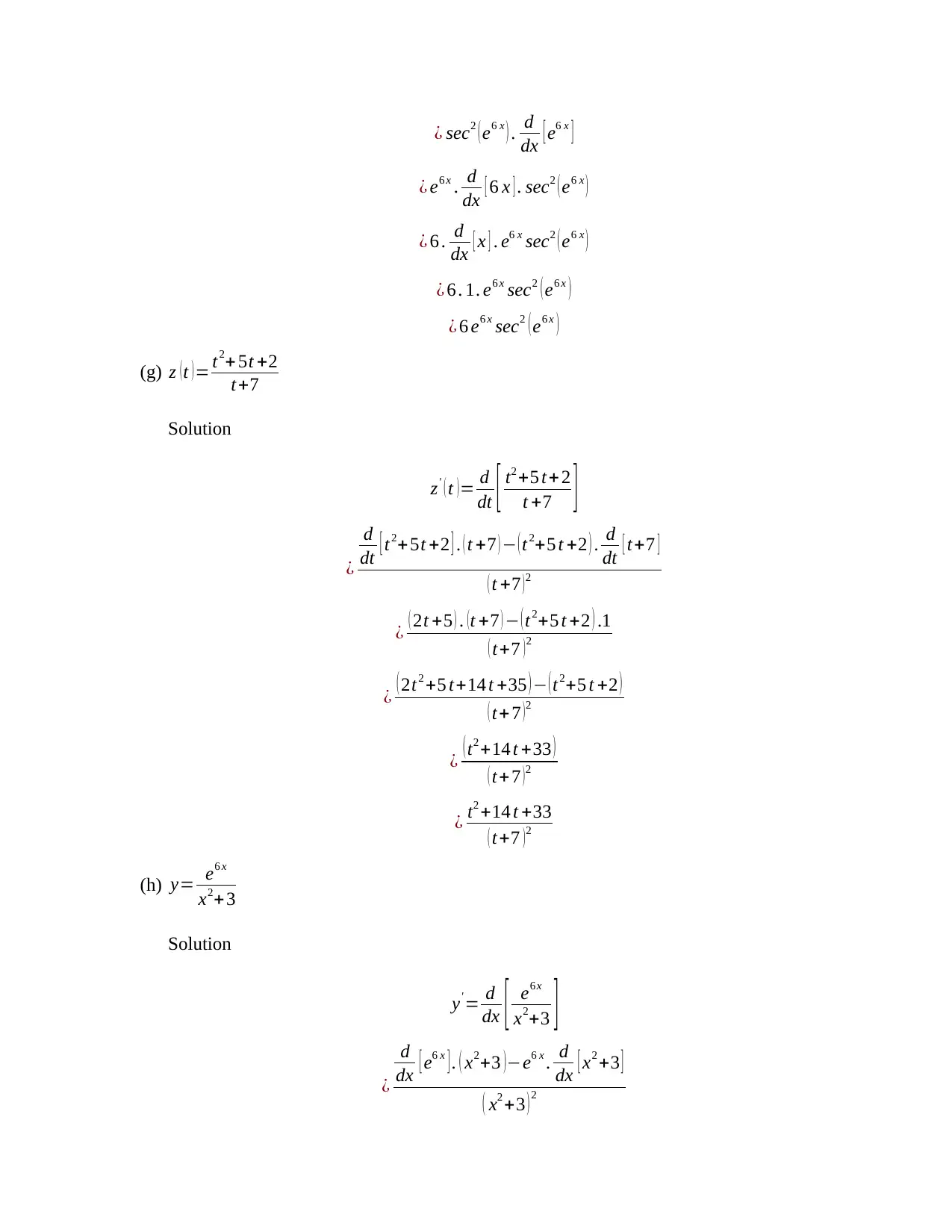
¿ sec2 ( e6 x ) . d
dx [ e6 x ]
¿ e6 x . d
dx [ 6 x ] . sec2 ( e6 x )
¿ 6 . d
dx [ x ] . e6 x sec2 ( e6 x )
¿ 6 . 1. e6 x sec2 ( e6 x )
¿ 6 e6 x sec2 ( e6 x )
(g) z (t )= t2+ 5t +2
t+7
Solution
z' ( t )= d
dt [ t2 +5 t+ 2
t +7 ]
¿
d
dt [ t2+ 5t +2 ] . ( t +7 ) − ( t2+5 t +2 ) . d
dt [ t+7 ]
( t +7 ) 2
¿ ( 2t +5 ) . ( t +7 ) − ( t2+5 t +2 ) .1
( t+7 ) 2
¿ ( 2t2 +5 t+14 t +35 ) − (t2+5 t +2 )
( t+ 7 )2
¿ ( t2 +14 t +33 )
( t+ 7 ) 2
¿ t2 +14 t +33
( t+7 ) 2
(h) y= e6 x
x2+3
Solution
y' = d
dx [ e6 x
x2+3 ]
¿
d
dx [ e6 x ] . ( x2+3 )−e6 x . d
dx [ x2 +3 ]
( x2 +3 ) 2
dx [ e6 x ]
¿ e6 x . d
dx [ 6 x ] . sec2 ( e6 x )
¿ 6 . d
dx [ x ] . e6 x sec2 ( e6 x )
¿ 6 . 1. e6 x sec2 ( e6 x )
¿ 6 e6 x sec2 ( e6 x )
(g) z (t )= t2+ 5t +2
t+7
Solution
z' ( t )= d
dt [ t2 +5 t+ 2
t +7 ]
¿
d
dt [ t2+ 5t +2 ] . ( t +7 ) − ( t2+5 t +2 ) . d
dt [ t+7 ]
( t +7 ) 2
¿ ( 2t +5 ) . ( t +7 ) − ( t2+5 t +2 ) .1
( t+7 ) 2
¿ ( 2t2 +5 t+14 t +35 ) − (t2+5 t +2 )
( t+ 7 )2
¿ ( t2 +14 t +33 )
( t+ 7 ) 2
¿ t2 +14 t +33
( t+7 ) 2
(h) y= e6 x
x2+3
Solution
y' = d
dx [ e6 x
x2+3 ]
¿
d
dx [ e6 x ] . ( x2+3 )−e6 x . d
dx [ x2 +3 ]
( x2 +3 ) 2
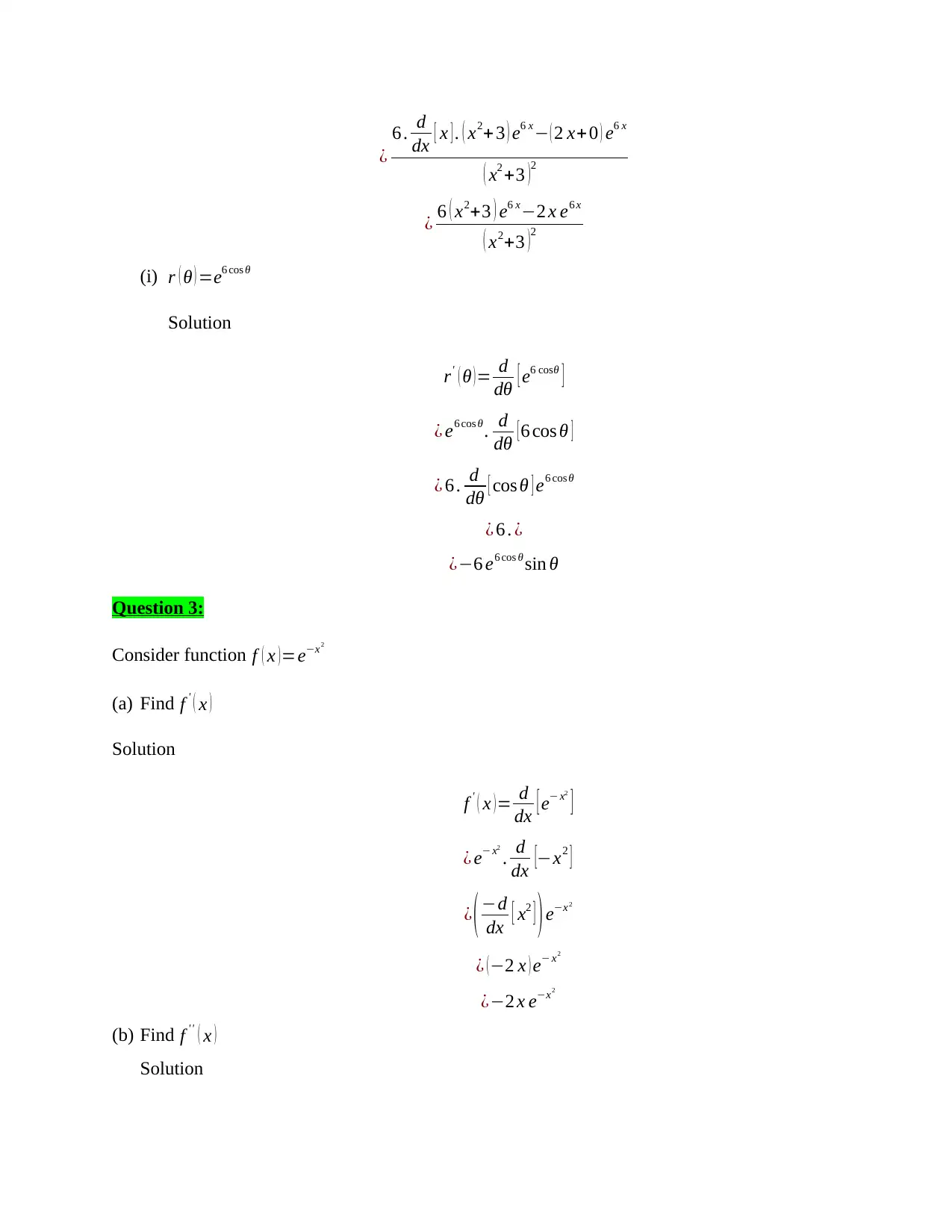
¿
6 . d
dx [ x ] . ( x2+ 3 ) e6 x− ( 2 x+0 ) e6 x
( x2 +3 )
2
¿ 6 ( x2+3 ) e6 x−2 x e6 x
( x2+3 )2
(i) r ( θ ) =e6 cos θ
Solution
r' ( θ )= d
dθ [ e6 cosθ ]
¿ e6 cos θ . d
dθ [6 cos θ ]
¿ 6 . d
dθ [ cos θ ] e6 cos θ
¿ 6 . ¿
¿−6 e6 cos θ sin θ
Question 3:
Consider function f ( x )=e−x2
(a) Find f ' ( x )
Solution
f ' ( x )= d
dx [ e− x2
]
¿ e− x2
. d
dx [−x2 ]
¿ (−d
dx [ x2 ] )e−x2
¿ (−2 x ) e− x2
¿−2 x e−x2
(b) Find f ' ' ( x )
Solution
6 . d
dx [ x ] . ( x2+ 3 ) e6 x− ( 2 x+0 ) e6 x
( x2 +3 )
2
¿ 6 ( x2+3 ) e6 x−2 x e6 x
( x2+3 )2
(i) r ( θ ) =e6 cos θ
Solution
r' ( θ )= d
dθ [ e6 cosθ ]
¿ e6 cos θ . d
dθ [6 cos θ ]
¿ 6 . d
dθ [ cos θ ] e6 cos θ
¿ 6 . ¿
¿−6 e6 cos θ sin θ
Question 3:
Consider function f ( x )=e−x2
(a) Find f ' ( x )
Solution
f ' ( x )= d
dx [ e− x2
]
¿ e− x2
. d
dx [−x2 ]
¿ (−d
dx [ x2 ] )e−x2
¿ (−2 x ) e− x2
¿−2 x e−x2
(b) Find f ' ' ( x )
Solution
⊘ This is a preview!⊘
Do you want full access?
Subscribe today to unlock all pages.

Trusted by 1+ million students worldwide
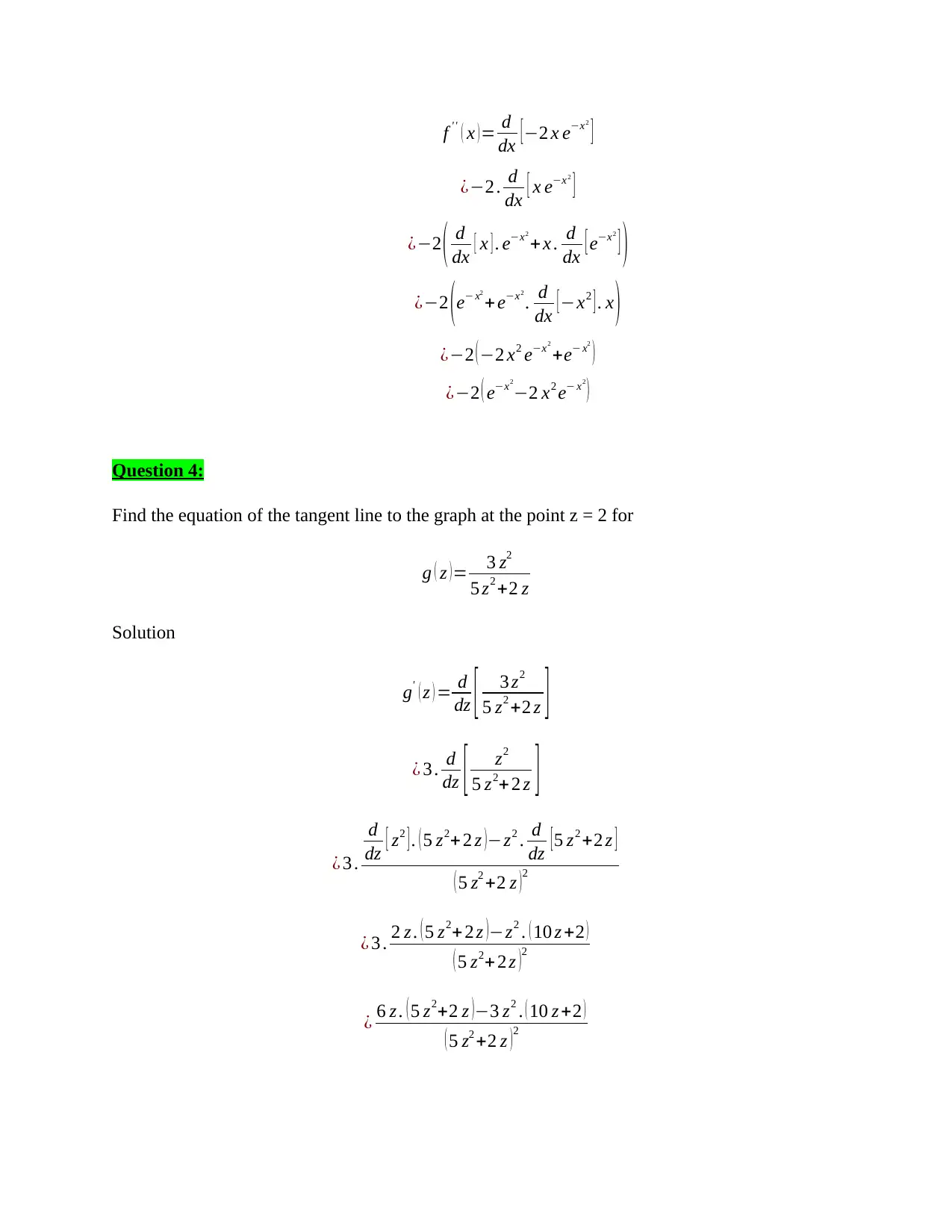
f ' ' ( x ) = d
dx [ −2 x e−x2
]
¿−2 . d
dx [ x e−x2
]
¿−2 ( d
dx [ x ] . e−x2
+ x . d
dx [ e−x2
] )
¿−2 ( e− x2
+ e−x2
. d
dx [ −x2 ] . x )
¿−2 ( −2 x2 e−x2
+e− x2
)
¿−2 ( e−x2
−2 x2 e− x2
)
Question 4:
Find the equation of the tangent line to the graph at the point z = 2 for
g ( z )= 3 z2
5 z2 +2 z
Solution
g' ( z ) = d
dz [ 3 z2
5 z2 +2 z ]
¿ 3 . d
dz [ z2
5 z2+ 2 z ]
¿ 3 .
d
dz [ z2 ] . ( 5 z2+2 z )−z2 . d
dz [ 5 z2 +2 z ]
( 5 z2 +2 z )
2
¿ 3 . 2 z . ( 5 z2+ 2 z )−z2 . ( 10 z +2 )
( 5 z2+ 2 z )2
¿ 6 z . ( 5 z2+2 z )−3 z2 . ( 10 z +2 )
( 5 z2 +2 z ) 2
dx [ −2 x e−x2
]
¿−2 . d
dx [ x e−x2
]
¿−2 ( d
dx [ x ] . e−x2
+ x . d
dx [ e−x2
] )
¿−2 ( e− x2
+ e−x2
. d
dx [ −x2 ] . x )
¿−2 ( −2 x2 e−x2
+e− x2
)
¿−2 ( e−x2
−2 x2 e− x2
)
Question 4:
Find the equation of the tangent line to the graph at the point z = 2 for
g ( z )= 3 z2
5 z2 +2 z
Solution
g' ( z ) = d
dz [ 3 z2
5 z2 +2 z ]
¿ 3 . d
dz [ z2
5 z2+ 2 z ]
¿ 3 .
d
dz [ z2 ] . ( 5 z2+2 z )−z2 . d
dz [ 5 z2 +2 z ]
( 5 z2 +2 z )
2
¿ 3 . 2 z . ( 5 z2+ 2 z )−z2 . ( 10 z +2 )
( 5 z2+ 2 z )2
¿ 6 z . ( 5 z2+2 z )−3 z2 . ( 10 z +2 )
( 5 z2 +2 z ) 2
Paraphrase This Document
Need a fresh take? Get an instant paraphrase of this document with our AI Paraphraser
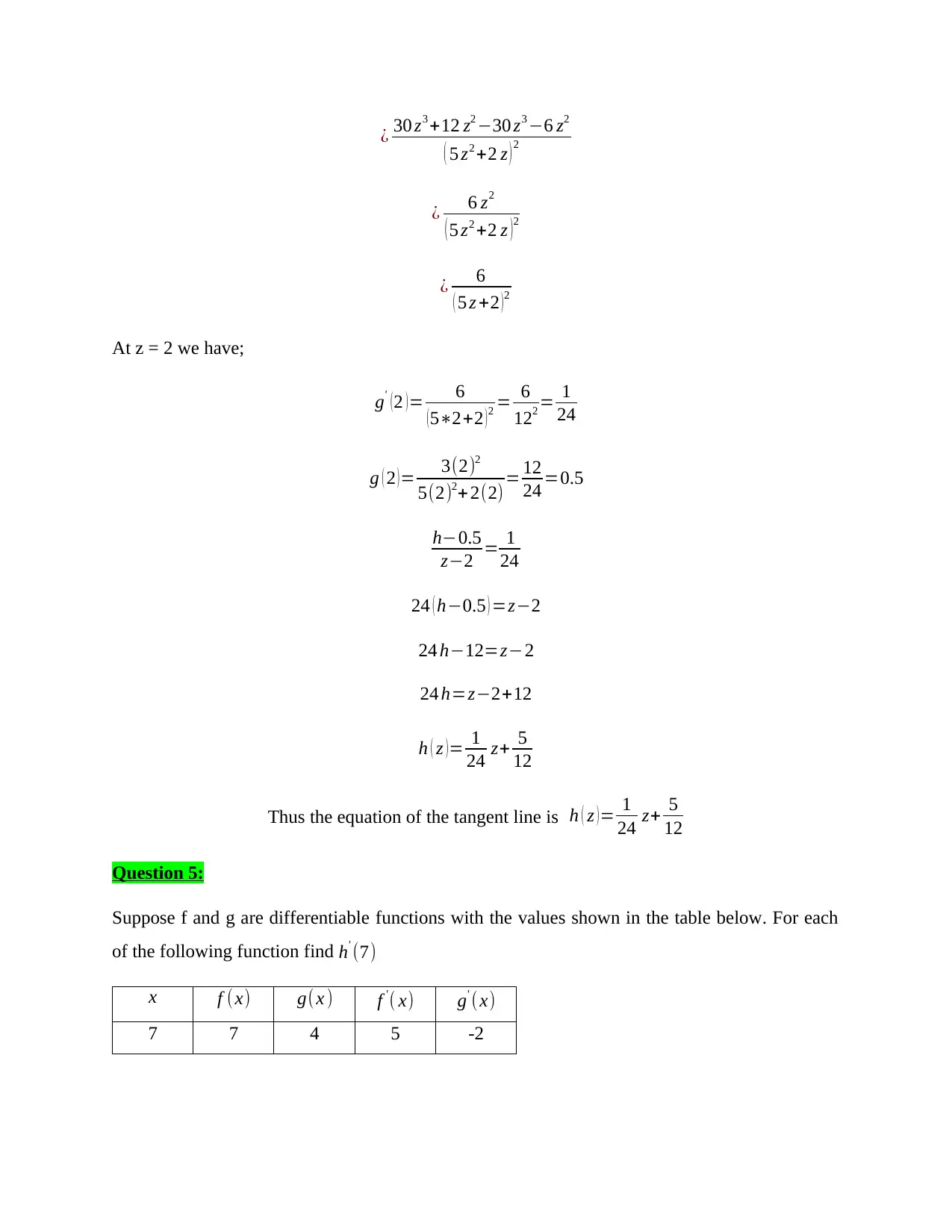
¿ 30 z3 +12 z2 −30 z3 −6 z2
( 5 z2 +2 z ) 2
¿ 6 z2
( 5 z2 +2 z )2
¿ 6
( 5 z +2 )2
At z = 2 we have;
g' ( 2 ) = 6
( 5∗2+2 ) 2 = 6
122 = 1
24
g ( 2 ) = 3(2)2
5(2)2+ 2(2)= 12
24 =0.5
h−0.5
z−2 = 1
24
24 ( h−0.5 ) =z−2
24 h−12=z−2
24 h=z−2+12
h ( z ) = 1
24 z+ 5
12
Thus the equation of the tangent line is h ( z ) = 1
24 z+ 5
12
Question 5:
Suppose f and g are differentiable functions with the values shown in the table below. For each
of the following function find h' (7)
x f (x) g(x ) f ' ( x) g' (x)
7 7 4 5 -2
( 5 z2 +2 z ) 2
¿ 6 z2
( 5 z2 +2 z )2
¿ 6
( 5 z +2 )2
At z = 2 we have;
g' ( 2 ) = 6
( 5∗2+2 ) 2 = 6
122 = 1
24
g ( 2 ) = 3(2)2
5(2)2+ 2(2)= 12
24 =0.5
h−0.5
z−2 = 1
24
24 ( h−0.5 ) =z−2
24 h−12=z−2
24 h=z−2+12
h ( z ) = 1
24 z+ 5
12
Thus the equation of the tangent line is h ( z ) = 1
24 z+ 5
12
Question 5:
Suppose f and g are differentiable functions with the values shown in the table below. For each
of the following function find h' (7)
x f (x) g(x ) f ' ( x) g' (x)
7 7 4 5 -2
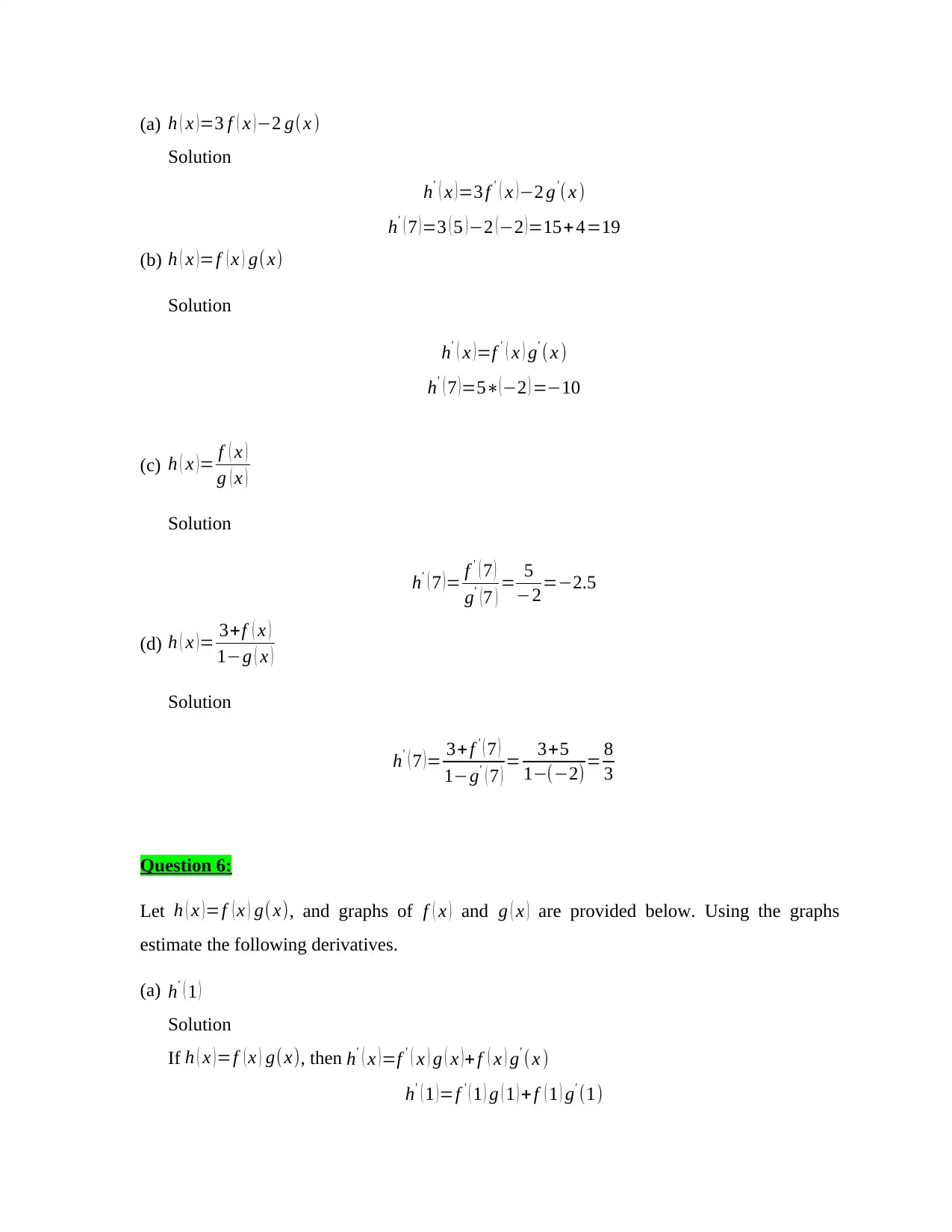
(a) h ( x ) =3 f ( x ) −2 g(x )
Solution
h' ( x ) =3 f ' ( x ) −2 g'( x )
h' ( 7 ) =3 ( 5 ) −2 ( −2 ) =15+4=19
(b) h ( x )=f ( x ) g( x)
Solution
h' ( x )=f ' ( x ) g' ( x )
h' ( 7 )=5∗(−2 ) =−10
(c) h ( x )= f ( x )
g ( x )
Solution
h' ( 7 )= f ' ( 7 )
g' (7 ) = 5
−2=−2.5
(d) h ( x )= 3+f ( x )
1−g ( x )
Solution
h' ( 7 ) = 3+ f ' ( 7 )
1−g' ( 7 ) = 3+5
1−(−2)= 8
3
Question 6:
Let h ( x ) =f ( x ) g( x), and graphs of f ( x ) and g ( x ) are provided below. Using the graphs
estimate the following derivatives.
(a) h' ( 1 )
Solution
If h ( x )=f ( x ) g(x), then h' ( x )=f ' ( x ) g ( x )+ f ( x ) g' ( x )
h' ( 1 )=f ' ( 1 ) g ( 1 ) + f ( 1 ) g' (1)
Solution
h' ( x ) =3 f ' ( x ) −2 g'( x )
h' ( 7 ) =3 ( 5 ) −2 ( −2 ) =15+4=19
(b) h ( x )=f ( x ) g( x)
Solution
h' ( x )=f ' ( x ) g' ( x )
h' ( 7 )=5∗(−2 ) =−10
(c) h ( x )= f ( x )
g ( x )
Solution
h' ( 7 )= f ' ( 7 )
g' (7 ) = 5
−2=−2.5
(d) h ( x )= 3+f ( x )
1−g ( x )
Solution
h' ( 7 ) = 3+ f ' ( 7 )
1−g' ( 7 ) = 3+5
1−(−2)= 8
3
Question 6:
Let h ( x ) =f ( x ) g( x), and graphs of f ( x ) and g ( x ) are provided below. Using the graphs
estimate the following derivatives.
(a) h' ( 1 )
Solution
If h ( x )=f ( x ) g(x), then h' ( x )=f ' ( x ) g ( x )+ f ( x ) g' ( x )
h' ( 1 )=f ' ( 1 ) g ( 1 ) + f ( 1 ) g' (1)
⊘ This is a preview!⊘
Do you want full access?
Subscribe today to unlock all pages.

Trusted by 1+ million students worldwide
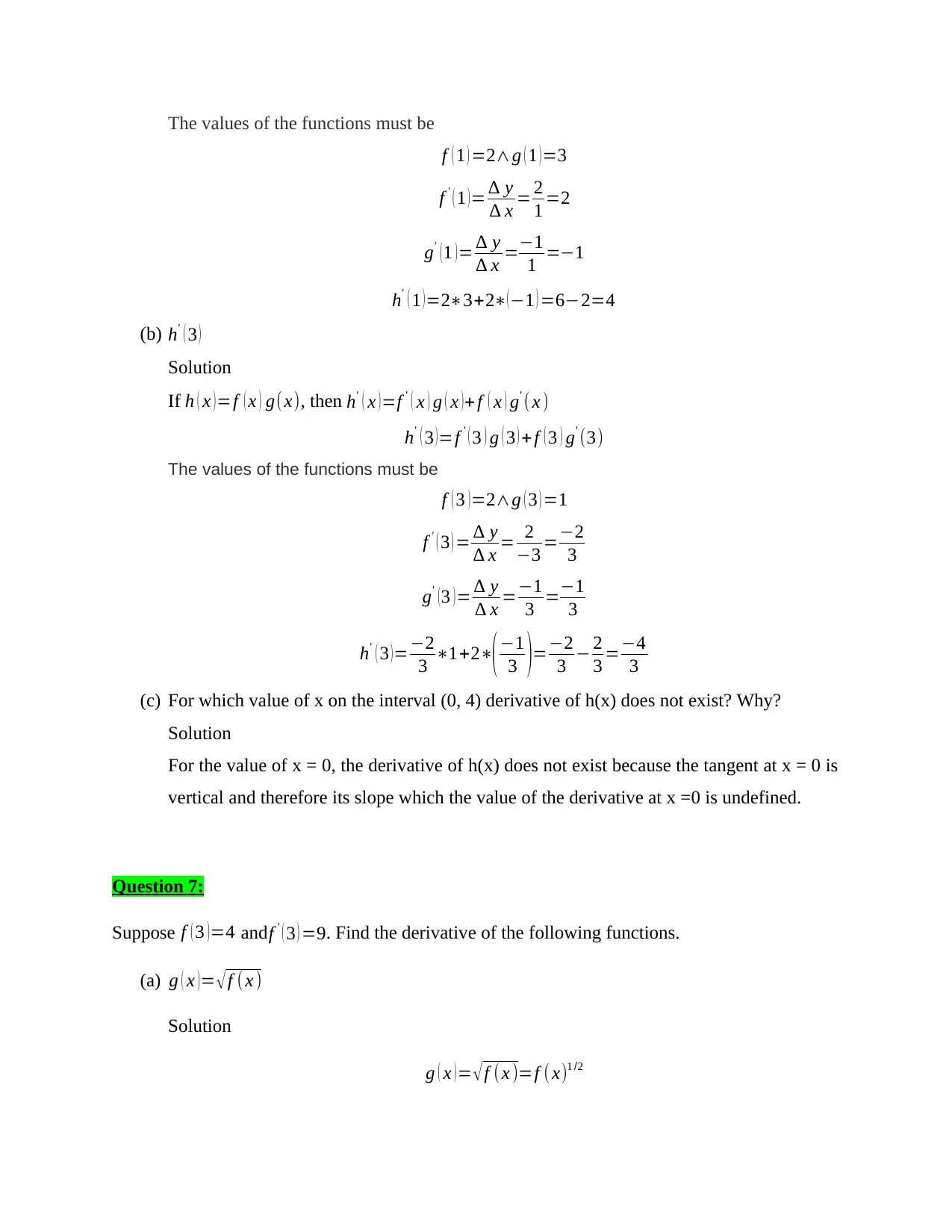
The values of the functions must be
f ( 1 ) =2∧g ( 1 )=3
f ' ( 1 )= ∆ y
∆ x = 2
1 =2
g' ( 1 ) = ∆ y
∆ x =−1
1 =−1
h' ( 1 ) =2∗3+2∗( −1 ) =6−2=4
(b) h' ( 3 )
Solution
If h ( x ) =f ( x ) g(x), then h' ( x )=f ' ( x ) g ( x )+ f ( x ) g' ( x )
h' ( 3 )=f ' ( 3 ) g ( 3 ) + f ( 3 ) g' (3)
The values of the functions must be
f ( 3 )=2∧g ( 3 ) =1
f ' ( 3 ) = ∆ y
∆ x = 2
−3 =−2
3
g' (3 )= ∆ y
∆ x =−1
3 =−1
3
h' ( 3 )=−2
3 ∗1+2∗(−1
3 )=−2
3 − 2
3 =−4
3
(c) For which value of x on the interval (0, 4) derivative of h(x) does not exist? Why?
Solution
For the value of x = 0, the derivative of h(x) does not exist because the tangent at x = 0 is
vertical and therefore its slope which the value of the derivative at x =0 is undefined.
Question 7:
Suppose f ( 3 )=4 and f ' ( 3 ) =9. Find the derivative of the following functions.
(a) g ( x ) = √ f ( x )
Solution
g ( x )= √f (x )=f ( x)1 /2
f ( 1 ) =2∧g ( 1 )=3
f ' ( 1 )= ∆ y
∆ x = 2
1 =2
g' ( 1 ) = ∆ y
∆ x =−1
1 =−1
h' ( 1 ) =2∗3+2∗( −1 ) =6−2=4
(b) h' ( 3 )
Solution
If h ( x ) =f ( x ) g(x), then h' ( x )=f ' ( x ) g ( x )+ f ( x ) g' ( x )
h' ( 3 )=f ' ( 3 ) g ( 3 ) + f ( 3 ) g' (3)
The values of the functions must be
f ( 3 )=2∧g ( 3 ) =1
f ' ( 3 ) = ∆ y
∆ x = 2
−3 =−2
3
g' (3 )= ∆ y
∆ x =−1
3 =−1
3
h' ( 3 )=−2
3 ∗1+2∗(−1
3 )=−2
3 − 2
3 =−4
3
(c) For which value of x on the interval (0, 4) derivative of h(x) does not exist? Why?
Solution
For the value of x = 0, the derivative of h(x) does not exist because the tangent at x = 0 is
vertical and therefore its slope which the value of the derivative at x =0 is undefined.
Question 7:
Suppose f ( 3 )=4 and f ' ( 3 ) =9. Find the derivative of the following functions.
(a) g ( x ) = √ f ( x )
Solution
g ( x )= √f (x )=f ( x)1 /2
Paraphrase This Document
Need a fresh take? Get an instant paraphrase of this document with our AI Paraphraser
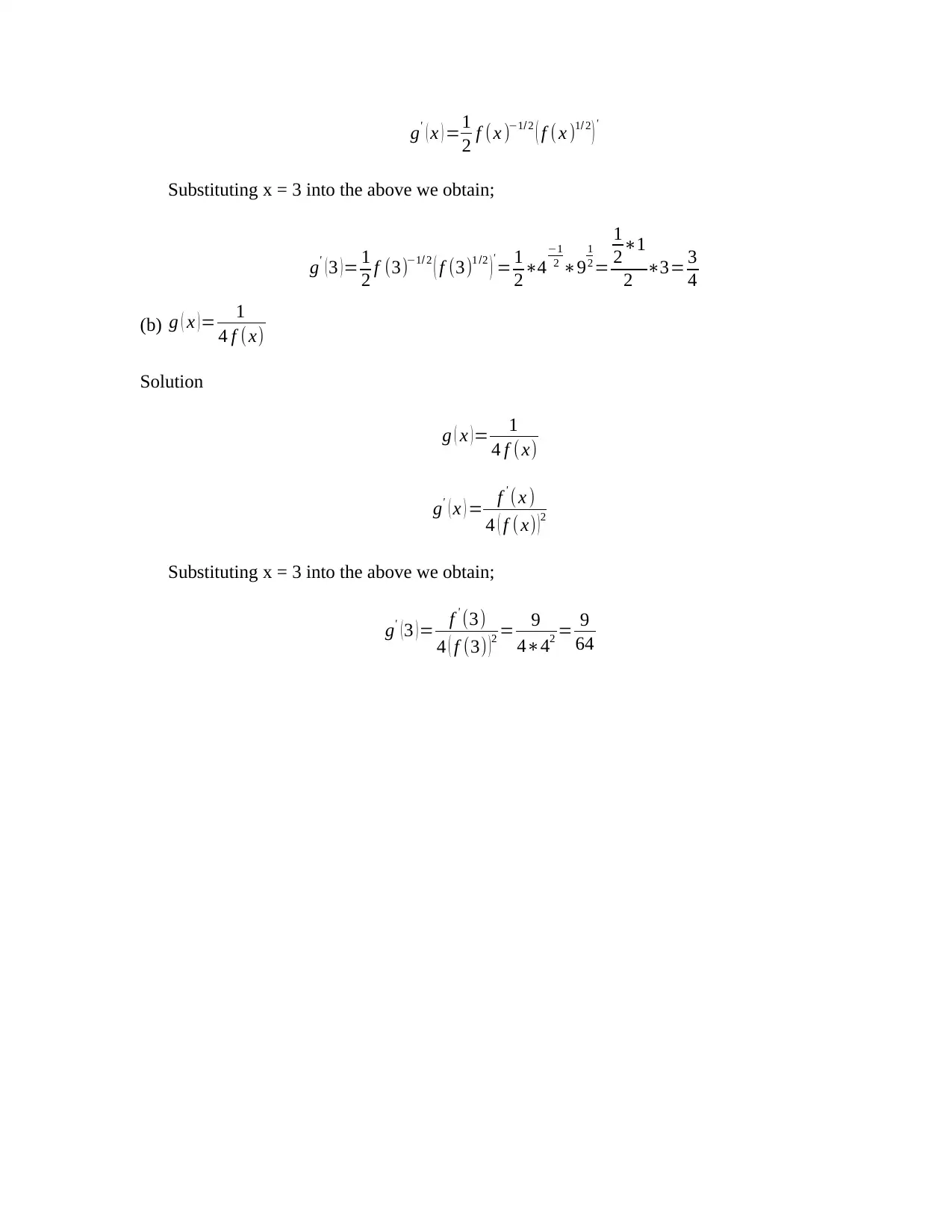
g' ( x ) =1
2 f (x )−1/ 2 ( f ( x )1/ 2 )'
Substituting x = 3 into the above we obtain;
g' (3 )= 1
2 f (3)−1/ 2 ( f (3)1 /2 )'
= 1
2∗4
−1
2 ∗9
1
2 =
1
2∗1
2 ∗3= 3
4
(b) g ( x ) = 1
4 f (x)
Solution
g ( x )= 1
4 f ( x)
g' ( x ) = f ' (x )
4 ( f (x) ) 2
Substituting x = 3 into the above we obtain;
g' (3 )= f ' (3)
4 ( f (3) )2 = 9
4∗42 = 9
64
2 f (x )−1/ 2 ( f ( x )1/ 2 )'
Substituting x = 3 into the above we obtain;
g' (3 )= 1
2 f (3)−1/ 2 ( f (3)1 /2 )'
= 1
2∗4
−1
2 ∗9
1
2 =
1
2∗1
2 ∗3= 3
4
(b) g ( x ) = 1
4 f (x)
Solution
g ( x )= 1
4 f ( x)
g' ( x ) = f ' (x )
4 ( f (x) ) 2
Substituting x = 3 into the above we obtain;
g' (3 )= f ' (3)
4 ( f (3) )2 = 9
4∗42 = 9
64
1 out of 11
Related Documents
Your All-in-One AI-Powered Toolkit for Academic Success.
+13062052269
info@desklib.com
Available 24*7 on WhatsApp / Email
![[object Object]](/_next/static/media/star-bottom.7253800d.svg)
Unlock your academic potential
Copyright © 2020–2025 A2Z Services. All Rights Reserved. Developed and managed by ZUCOL.





